Posted by Powee Celdran
“In the international and religious conflict of the Byzantine and Saracen empires, peace was without confidence, and war without mercy.” -Edward Gibbon, English historian (1737-1794)

Welcome once again back to another article by the Byzantium Blogger! The last 2 articles I published were sure extremely long but hopefully insightful and informative covering not only Byzantine history but the histories of other countries that had been influenced by Byzantium, had once been part of Byzantium, or in some ways succeeded the Byzantine state itself and by having to explain how Byzantium made its mark on each country as well as making it an article on geography, these 2 previous articles had to be very long. This article, like the last 2 will be another one with a focus on both Byzantine history and geography as this one will be a geographical, cultural, and historical guide to the many military-administered provinces of the Byzantine Empire known as the Themes which were created from the 7th century onwards. This will be another very long one but not as long and will be more evenly spaced compared to the last one as it will cover all the Themes in Byzantine history which number up to more than 40 in total. The rest of this article will give short descriptions of all the themes throughout the empire’s history, places and modern countries controlled by them, the story of how these themes formed from the previous provinces of the Eastern Roman Empire and collapsed due to major conflicts, themes created out of them, the people and army that lived in them, significance in Byzantine history, its geography, famous Byzantines that came from them, and pictures of places found in them today but also to keep it simple, I won’t go too much on its local economy, exact number of soldiers, net worth, and politics unless they had a great influence on Byzantium as a whole. The quote above by the English historian Edward Gibbon refers to the situation of the Byzantine Empire from the 7th century onwards especially with the constant wars with the Arabs that made the reduced Byzantine Empire adapt to a new system of creating smaller military controlled provinces called the Themes. Take note that this article will be labelled in bullet form starting with the original Themes (labelled in Roman numerals I-VI) and below them the Themes that formed from them while additional Themes will be in bullet points as well with a short description and the maps showing their location.

Note: This article is about the Themes or provinces of the Byzantine Empire and the word “Theme” in this article will always have the letter “T” capitalised to differentiate it from the word “theme”. The original Themes will be labelled in Roman numerals with Themes mentioned under them while the ones formed on their own will not be labelled with any numbers. I will also be using the Latinized names for the Themes rather than their actual Greek names.
Warning: THIS IS A VERY LONG ARTICLE!!
Other Articles from the Byzantium Blogger:
15 Byzantine Related States Outside Byzantium Part1 (1-7)
15 Byzantine Related States Outside Byzantium Part2, Where did Byzantium go? (8-15)
7 Reasons to be Interested in Byzantium
Byzantium: The Surprising Life of a Medieval Empire
Byzantine Science and Technology
Crime, Punishment, and Medical Practice in the Byzantine World
The Art of War in the Byzantine World
The Complete Genealogy of Byzantine Emperors
An Intro to the Thematic System
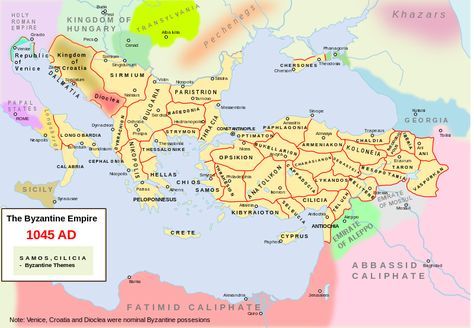
To give a brief history to the Themes of the Byzantine Empire, Byzantium initially began with a large territory when it became the Eastern half of the Roman Empire in 395 while the Western half of the Roman Empire (Western Roman Empire) gradually declined eventually losing everything they held in 476. The east however managed to survive the all of the west and even expanded farther in territory by reconquering the lost western Roman provinces. During the reign of Justinian I (527-565), the Byzantines based in Constantinople reached the point where their empire was at its greatest extent controlling the whole Mediterranean and including Italy, Southern Spain, North Africa known the Maghreb, Egypt, Palestine, Syria, Asia Minor (Turkey), Greece, the Balkans (Southeastern Europe), and the Crimea in the north of the Black Sea (Ukraine). The large Byzantine Empire of Justinian I was administered by having large territories of land divided into provinces, still keeping the Roman Provincial System of having a governor administering large territories then called a Diocese of land together with a general commanding the armies stationed there, though after Justinian I’s death, this system became too hard for the emperors ruling at Constantinople that 2 semi-autonomous larger provinces known as Exarchates were created by the emperor Maurice (r. 582-602) governed by an Exarch who was acted as a junior emperor; the 2 Exarchates controlled by an exarch were Italy based in Ravenna and Africa based in Carthage. The empire in its greatest extent however did not last long and in less than a century after Justinian I’s death in 565, Byzantium had quickly lost its territories during the reign of Heraclius (610-641); at this point, even if Byzantium’s long-time mortal enemy, the Sassanid Persian Empire had been defeated, a new threat which were the Arabs that have risen so quickly from the Arabian Peninsula took over Egypt and the areas of the Middle East once controlled by Byzantium threatening to attack Constantinople itself while at Italy, the Lombards have been threatening the empire, and in Greece, the Slavs and Avars have had constant raids taking away most of imperial territory. With the main empire severely reduced to Greece and Asia Minor losing the rich and populous parts which were Syria and Egypt to the Arabs by the death of Emperor Heraclius in 641- although still having the Exarchates of Italy and Africa- the empire had to adopt a new governing system for what was left of it. This new system the empire has created was the Thematic System where provinces were reduced in size and so was the army and these smaller provinces called the Themes had to be created to make recruitment of soldier’s easier and to concentrate them in a smaller area in order to protect its new eastern borders- the Taurus Mountains of Asia Minor- against the invading Arabs. Since Asia Minor became the empire’s heartland, the Byzantine emperors of the 7th century created the first 4 Themes (Thema in Greek) there which were namely the Opsician, Anatolic, Armeniac, and Cibyrrhaeot Themes. These Themes however would be further divided into smaller Themes by the end of the 7th century with a total of 13 Themes, and by the 10th century when Byzantium had returned again to a golden age of military power, the empire was further divided into 29 Themes from the existing ones with some only being frontier military provinces to further defend the empire, and by the 11th century after the Byzantines conquered new lands, the empire had a total of 38 Themes, although in the whole history of Byzantium there were more than 40 Themes as some fell and rose at different times. The major turning point that would be the collapse of many of the empire’s Themes in Asia Minor (Asian Turkey) was the Battle of Manzikert in 1071 where the Seljuk Turks defeated the Byzantines at battle and took over almost the entire Asia Minor while in 1204, the empire itself met its temporary end to the 4th Crusade putting an end to the Themes as the empire was divided, although it was restored in 1261 but never recovered its old glory and size again until its final fall in 1453. The Themes were said to be created by the emperor Constans II (r. 641-668) as early as he began his reign as he adapted to the change of the empire’s shrunken borders but saw that Constantinople was in a critical position of being invaded making him flee to Sicily until he was assassinated there, thus keeping the capital at Constantinople. The Themes were created by the army and named after the army units depending on their ethnicities as well as the ethnicities of the people living in them while the Themes were governed by a general called a Strategos, once the Magister Militum of the early empire and he was responsible for recruiting his army from the farmers and locals which would become the Thematic army known as the Tagmata and stronger units would be the elite cavalry known as the Cataphracts (Kataphraktoi in Greek) as well as being responsible for levying taxes from this area as the empire had grown smaller and taxes were needed to be collected from more concentrated areas. What was different however compared to the times of the Roman Empire was that the provinces back then did not contain that much people but during the times of the Byzantines, populations grew within the empire especially because of migrations and regions such as those in Greece and Asia Minor became densely populated that smaller provinces had to be created to administer a growing population. This system Byzantium had in managing their territories had been similar to the way it was in Western Europe which was the Feudal system except that unlike in Western Europe where nobles owned the land, in Byzantium it was still the empire that owned the land and Strategos that controlled it as well as the soldiers were only assigned there to protect it while its citizens had to provide for them. The Themes of the empire also had to provide resources for the empire itself aside from soldiers; which meant that the richer themes having mines and fertile land provided more and were more powerful while those that didn’t have much remained small. The Strategos that had had controlled a Theme would sometimes begin to grow so powerful that he’d could start a rebellion to overthrow the emperor or raise an army to fight the other Themes, so the solution emperors came up with to reduce the power of the Strategos and his army was to divide the larger original Themes creating smaller ones so that its leader won’t be too powerful to start a rebellion. By the 10th, 11th, and 12th centuries, new Byzantine conquests had created much smaller Themes to serve as frontier states but were small in size that they only used as military bases to further protect the empires borders, especially in the east which was where all these little and insignificant Themes were formed. It was during this time when Byzantium was beginning the Theme System which would alst a long time that they would start becoming more Greek putting behind their Roman heritage and systems in the past as they had already started speaking Greek rather than Latin which they had. These Themes on the other hand were effective enough to keep the Byzantine Empire running for centuries as it saved it from its near collapse in the 7th and 8th centuries.
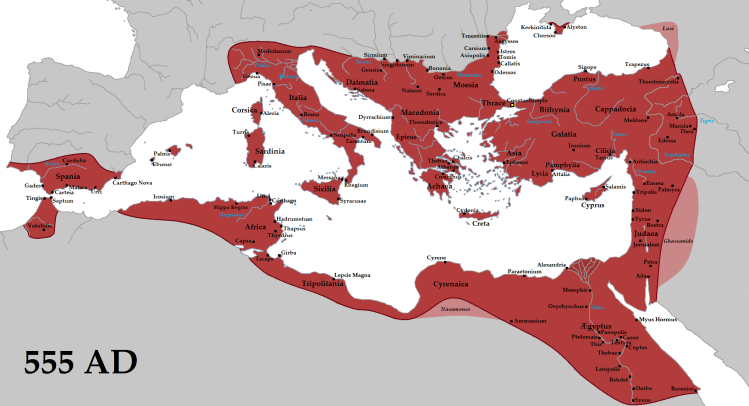

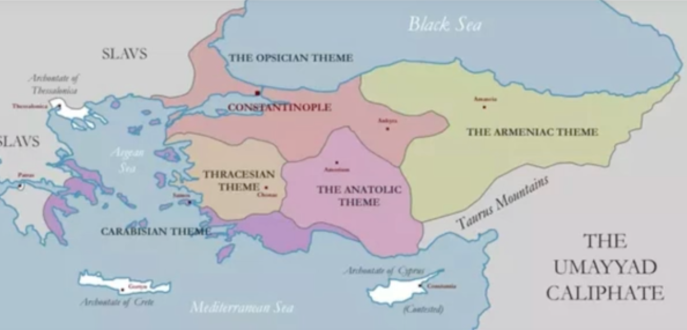


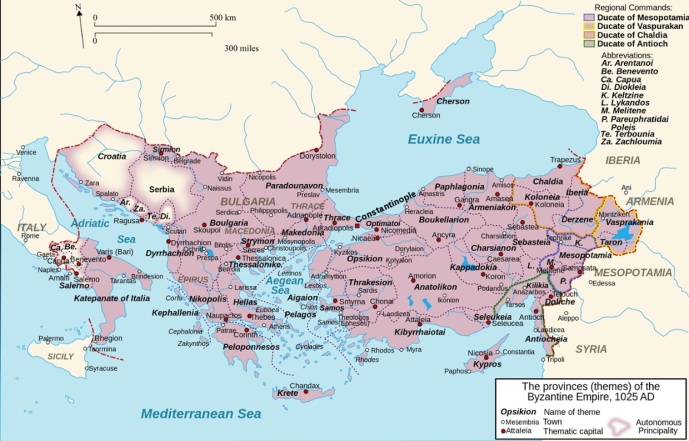
The Original Themes and Themes Formed Under Them
Present countries under the area of the original Themes: Turkey, Greece, Bulgaria, Armenia, Italy
I. The Anatolic Theme

One of the first Themes or military-civilian provinces of the Byzantine Empire to be formed back in the 7th century was the Anatolic Theme (Anatolikon in Greece) which at first controlled a large part of central and western Asia Minor- also known as Anatolia (today’s Turkey)- from the Aegean Sea in the west to the heart of Anatolia down to the southern Mediterranean coast. This Theme at first controlled the Anatolian regions of Lycaonia, Pisidia, Isauria, parts of Cappadocia in the east, and most of Phrygia in its west while its capital was Amorion in Phryigia. The date of creation of the Anatolic Theme is relatively unknown but as it was one of the first, it was created in around 669 at the beginning of the reign of Constantine IV (r. 668-685) and formed by the army of the east commanded by the Magister Militum per Orientem fleeing into Asia Minor from Arab attacks in the east, the Magister Militum then became the Theme’s military governor renamed the Strategos, its people on the other hand mainly consisted of Byzantine Greeks, Syrians, and Armenians. Over the centuries, the Anatolic Theme would be constantly attacked by Arab raids from the east but its fall in 1078 was not to the Arabs but to the Central Asian Seljuk Turks who defeated the Byzantines earlier at Manzikert in 1071. Its geography consisted of fertile lands in the west, lakes, rivers, and rocky mountains while its other main cities included Iconium, Tyana, Sozopolis, and Akroinon which were all inland cities; in the 10th century, an Arab geographer describes the Anatolic Theme as the largest of the Byzantine provinces having an army of 15,000 men and 34 fortresses. Notable people who were the Strategoi or generals of this Theme were the usurping emperors Leontios (r. 695-698), Leo III the Isaurian (r. 717-741) who began the Isaurian Dynasty, and Leo V the Armenian (r. 813-820), those 3 weren’t exactly born here, although the emperor Michael II (r. 820-829) was from the city of Amorion as he was called “the Amorian”, meanwhile the Palaiologos imperial family (1261-1453) is to have originated in this Theme. The Anatolic Theme was a long lasting one and only 2 Themes formed out of it, the Themes of Cappadocia and the Thracesians.
Formed from the Anatolic Theme:
Theme of Cappadocia
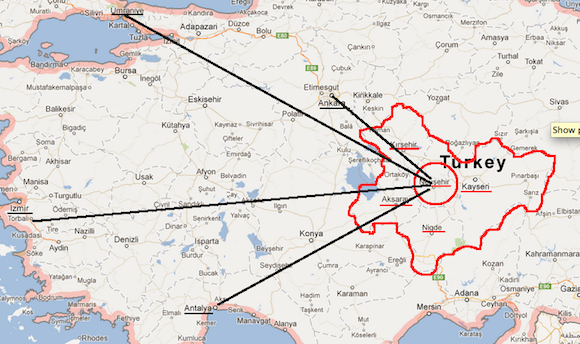
Formed from the Anatolic and Armeniac Themes by 830 during the reign of Emperor Theophilos the Amorian (r. 829-842) was the Theme of Cappadocia made to strengthen the empire’s eastern borders against more Arab raids. The Theme of Cappadocia was not so large and bordered at the northwest by the Bucellaian Theme, northeast by the Halys River and across it the Charsianon Theme, west by the Anatolic Theme, and south by the Taurus Mountains, the empire’s border with the Arab Caliphates. The Cappadocian Theme was named after the area it was in, the rocky region of Cappadocia known for ancient churches within the caves of the rock formations, it was once a Roman province with the same name and its inhabitants were Byzantine Greeks, Armenians, Syrians, and a few Arabs that settled in; the region too has many rivers and lakes such as Lake Tuz. From here came the powerful military Phokas family where Emperor Nikephoros II (r. 963-969) was from; many men of the Phokas and Maleinos families that lived here controlled the province as its Strategoi. Even before Cappadocia was a Theme, many famous Byzantines came from here including the 6th century finance minister John the Cappadocian and the emperor Maurice (r. 582-602), and it is said the imperial Laskaris family that ruled Nicaea from 1204-1261 originated here as well. The Theme’s capital was at first the Fortress of Koron until it was moved to the city of Tyana and this Theme only fell sometime in the 1070s to the Seljuks.

Thracesian Theme

Sometime in the early 8th century, the western portion of the Anatolic Theme along the Aegean coast separated to form the Thracesian Theme, which is named after the Thracian Army units that founded it despite it being located in Western Asia Minor and not Thrace, although it is said that its name came from the Thracian population here that settled ever since the 6th century BC when this was still under the Ancient Greek Kingdom of Lydia. By the start of the 10th century, the Aegean islands of the coast of Asia Minor including Ephesus and Smyrna became part of the Theme of Samos while the Thracesian Theme remained controlling the inland parts east of Ephesus which included the regions of Lydia, Northern Caria, and Phrygia while consisting of the cities of Sardis which was once the ancient capital of Lydia, Pergamon known for the ancient library, Hierapolis known for its hot springs and white mineral formations while the capital was more inland at Chonae. This Theme may have been a backwater location but had a strong army of 6,000 up to 10,000, was the place said to where the Angelos imperial family (1185-1294) originated in and in one story, it was here in 1038 in the Thracesian Theme where a soldier of the Nordic Varangian Guard unit tried to abduct a woman who grab his sword and killed him; its ships were at the sea controlled by the Samos Theme. This Theme was one of those that remained strong despite falling to the Seljuks for only 1 year (1078-1079) and retaken by the Byzantines, falling under the Empire of Nicaea from 1204-1261, but finally falling to the rising Ottomans in the 1330s being one of the last parts of Asia Minor under Byzantine control and one of the longest surviving Themes.

II. The Armeniac Theme

The next of the 4 original Themes to be created in Asia Minor during the 7th century was the Armeniac Theme (Thema Armeniakon in Greek) created out of the old province called Armenia Minor; in fact the Armeniac Theme was said to have formed even as early as 629 when the emperor Heraclius was campaigning against the Sassanid Persian Empire. By the 660’s, the Armeniac Theme was officially established by the remnant Eastern Roman armies of northeastern Asia Minor under the command of the Magister Militum per Armeniae who then became its Strategos; the name of the Theme comes from the region of Armenian it was built it, the name of the army unit stationed in Armenia, and the Armenian people that lived in this part, which were a majority population. The Armeniac Theme where the army settled originally consisted of a large region of Asia Minor including the northern mountainous and Black Sea coastal regions of Pontus and Paphlagonia and the northern parts of inland Cappadocia while the capital where the Strategos based himself was the city of Amaseia (now Amasya in Turkey) and its eastern edge was the northeast border of the empire. This Theme had grown to be a powerful frontier province rich in minerals and by the 9th century had 17 fortresses and an army of 9,000 men which was still less compared to the Anatolic Theme, though the Armeniac had controlled a navy in the Black Sea; it was also in the 9th century when the large Armeniac Theme was broken up into a part of the Cappadocian Theme and the Themes of Chaldia, Charsianon, Koloneia, and Paphlagonia while the Theme of Sebasteia formed out of it in the 10th century. In this Theme, a notable Strategos was Artavasdos who became emperor for a year (742-743) while coming from Byzantine Armenia were the 6th century general Narses and the emperor Leo V (r. 813-820) while the emperors Heraclius (r. 610-641), Basil I (r. 867-886), Romanos I Lekapenos (r. 920-944), and John I Tzimiskes (r. 969-976) were of Armenian descent. The Armeniac Theme, though reduced in size to the cities of Amaseia, Gangra, Euchaita, and Sinope in Northeast Anatolia, this Theme survived until it fell to Frankish mercenaries in 1073 following Byzantium’s defeat in Manzikert (1071) to the Seljuks who then took over this Theme shortly after leaving only a few coastal areas to be recovered by the Byzantines.
Watch this for more info about the Battle of Manzikert (from Eastern Roman History).
Formed from the Armeniac Theme:
Theme of Chaldia
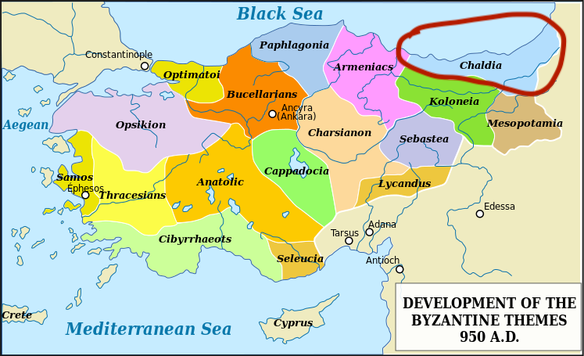
Part of the Themes that formed out of the larger Armeniac Theme in the 9th century was the Theme of Chaldia in the northeast corner of Asia Minor along the Black Sea, formed sometime between 820 and 840; it was named after the Chaldoi which were the people that lived here. Its capital where the Strategos was based in was the city of Trebizond which was in the coastal lowlands along the Black Sea as behind it and throughout the region were the high mountains known as the Pontic Alps; to the east of this Theme was already the border with Armenia and Lazica and to its south was the remaining Armeniac Theme. This Theme despite its relatively small size, an army of about only 4,000, 6 fortresses, and few settlements was rich in minerals such as silver from the mountains and had a mixed population of Byzantine Greeks, Armenians, Goergians or the Laz, and Pontic Greeks; although it also had a separatist tradition being an autonomous Theme from the Byzantine Empire under the Gabras family from 1095-1098 and from 1126-1140. This Theme evolved into the independent Empire of Trebizond ruled by the Komnenos Dynasty formed in 1204 as a remnant Byzantine state after the 4th Crusade captured Constantinople and this empire would live on until 1461 as the 2nd but not so powerful Byzantine Empire, though still getting rich from trade but still met its end to the Ottomans in 1461, 8 years after Constantinople did.

Theme of Charsianon

Once a part of the large Armeniac Theme, this part of northeast Asia Minor, north of Cappadocia was contested between the Arabs and the Byzantine Armeniac Theme until sometime between 863 and 873 when it became a Theme itself from its growing population and army. This Theme became known as the Charsianon Theme as it was first based in the Fortress of Charsianon, allegedly named after the 6th century emperor Justinian I’s general Charsios but eventually the capital was moved from this fort south to the city of Caesarea (now Kayseri, Turkey). This Theme shared many borders such as with Cappadocia in the south and the remains of the Armeniac Theme in the north while in it was fertile land along the River Halys; it also had a medium sized army of 4,000 men and 4 other fortresses. The land area of this Theme was in fact large that the aristocratic Argyros and Maleinos clans set up their estates there and by 1045, Armenians have settled in including their deposed king Gagik II leading to friction with the local Greek population. This Theme like a lot came to an end in 1071 when the Seljuks captured it following Manzikert.
Theme of Koloneia

The Theme of Koloneia was one of the smaller and more obscure Themes formed out of the Armeniac Theme as it also had a relatively obscure location in the northeast of Asia Minor, south of the Theme of Chaldia on the other side of the Pontic Mountains also within the region known as Armenia. Information about this Theme is mentioned in the De Administrando Imperio (DAI) by Emperor Constantine VII (r. 913-959) which mentions there were 16 unnamed fortresses here while its capital was also named Koloneia along the River Lykos and its cities were Satala, Nicopolis, and Neocaesarea. This land-locked Theme was formed sometime before 863 from the Armeniac Theme and fell also to the Seljuks in 1071.
Theme of Paphlagonia

The Theme of Paphlagonia in Northern Asia Minor is said to have either formed from the Armeniac or Bucellarian Theme, but most likely from the Armeniac Theme in around 820. This Theme consisted of the northern coastal area of Asia Minor along the Black Sea together with hilly and mountainous regions inland; its capital was the inland city of Gangra but this was only where the Strategos and his main army were as more activity happened in the coast such as in Amastris. The Theme had an army of 5000 soldiers as well as 5 forts and control of the navy; it was also where the emperor Michael IV the Paphlagonian (r. 1034-1041) and his nephew Michael V (r. 1041-1042) came from as well as where the Komnenos family were given large estates leading to their rise to power before ruling the empire. The Theme was eventually lost to the Seljuks also in 1071 but the coast was returned to Byzantine control in the 1130s by Emperor John II Komnenos, then after Constantinople fell to the 4th Crusade in 1204, Paphlagonia became under the Byzantine Empire of Trebizond as part of the territory of David Megas Komnenos in 1204 until taken by the Byzantines of Nicaea in 1214 and from then till 1380 it was under Byzantine control until falling to the Ottomans.
Theme of Sebasteia
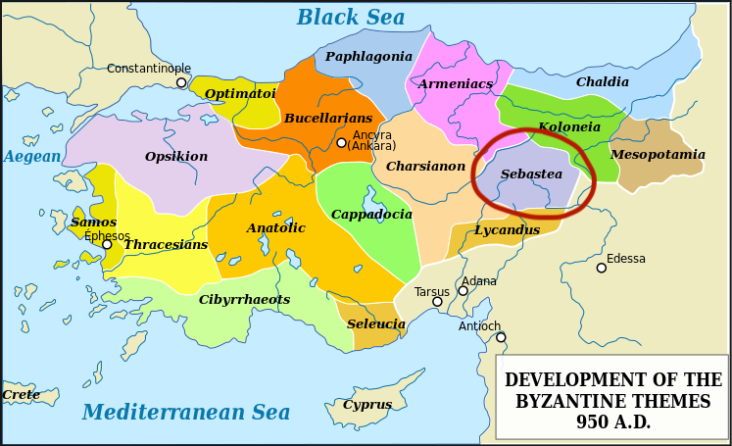
Formed in around 911 from the large Armeniac Theme during the reign of Emperor Leo VI the Wise of the Macedonian Dynasty, the Theme of Sebasteia remains relatively unknown except that its capital was the city of Sebasteia (now Sivas in Turkey) and was found the east of Asia Minor according to the DAI of Leo VI’s son Constantine VII. This small Theme was bordered to the north by the Armeniac and Koloneia Themes, west by the Charsianon Theme, and south by the empire’s border and in this Theme was the northern Euphrates River. Also, in the 10th century, many Armenians migrated into this Theme from the east and by 1021, this Theme was ceded from Byzantium to the Armenian Kingdom of Vaspurakan and was only conquered by the Seljuks in 1090.
III. The Opsician Theme

The largest and most prestigious of the first 4 Themes to form in Asia Minor in the 7th century was the Opsician Theme (Opsikion in Greek) as it was the Theme closest to Constantinople, the capital and had large amount of fertile land, lakes, and rivers. The Opsician Theme was formed sometime between 640 and 660 being one of the first Themes and originally consisted of the entire northwest of Asia Minor stretching from the Dardanelles Strait in the west to the Halys River in the east while also having the Black Sea to the north and in the northwest the Sea of Marmara, the Theme’s capital was Ancyra (today Ankara, the capital of Turkey). The Theme’s Greek name Opsikion comes from the Latin word Obsequium meaning “retinue” as this Theme was formed when the emperor’s retinue army units from Constantinople were settled here to defend Asia Minor from Arab raids, meanwhile the general that controlled this Theme did not use the title Strategos but instead, Komes (meaning count in Greek) for unknown reasons, and in 668, the Komes Mizizios of this Theme usurped Sicily after the assassination of Emperor Constans II, though Mizizios himself was executed and Constans II’s son Constantine IV became full emperor back in Constantinople. During both reigns of Constantine IV’s son Justinian II (685-695 and 705-711), the Opsician Theme was his powerbase where he had also Slavs from Thrace to strengthen his army; this Theme being one of the richest and most powerful originally had an army of 18,000 men that had supported many rebellions including the rise of Emperor Anastasius II in 713 and the rise of Leo III in 717; while it was also used as the base for the usurpation of the general Artavasdos against Constantine V from 741-742 and at this time also opposed the Iconoclast policies of the Isaurian emperors starting many revolts against them which failed. During the next reign of Constantine V (743-775), he reduced the size of the Opsician Theme to limit its power by creating the Bucellarian and Optimatoi Themes out of it- also parts of the Paphlagonian, Cappadocian, and Charsianon Themes were formed from it- while in the remaining Opsician Theme, the emperor created a strong Iconoclastic Tagmata guard regiment. By the 9th century, the new capital of the smaller Opsician Theme was Nicaea though according to the DAI of the 10th century emperor Constantine VII, the Theme still held the region of Mysia in Northwest Asia Minor and its many major cities including Abydos, Cyzicus, Parion, and Lampsacus along the south coast of the Marmara Sea. This Theme survived for a much longer time, even surviving the 4th Crusade of 1204 as it was incorporated to the exiled Byzantine Empire of Nicaea but in 1234 was dissolved when parts of it were taken by the Latins of Constantinople until it was brought back under the Byzantines for a short time until its eventual fall to the Ottomans in the 14th century.
Formed from the Opsician Theme:
The Bucellarian Theme
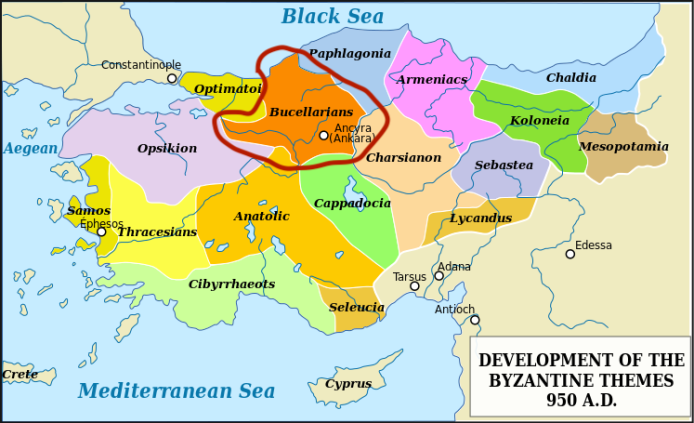
Sometime after 743 when Emperor Constantine V returned to power, the Bucellarian Theme was created out of the larger original Opsician Theme to reduce the power of the latter. This new Theme was named after the old Roman cavalry force known as the Bucellarii which had become bodyguard units for the Byzantine emperors as well; the Strategos in Theme from the 8th century was then based once again in Ancyra, the former capital of the larger Opsician Theme which became this Theme’s capital and even though not so large in size, the Theme had an army of 8,000 and a small fleet assembled in its small Black Sea coastal area. The Bucellarian Theme stretched from Ancyra in the rocky but fertile plateau region of Galatia in the south to a small part of the Black Sea in north while in the west it was bordered by the remaining Opsician Theme, to the south by the Anatolic and Cappadocian Themes, and to the east by the Themes of Charsianon and Paphlagonia. By the 9th century, this Theme had been reduced in size as its northern coastal areas ceded to the Paphlagonian Theme making the Bucellarian only have 2 towns but 13 fortresses. This Theme however managed to survive until falling to the Seljuk Turks in the 1070s following the Battle of Manzikert (1071).
Optimates Theme

The Latin word Optimates (Optimatoi in Greek) were an elite force of the early Eastern Roman (Byzantine) army created in 575 by the emperor Tiberius II (r. 574-582) as a cavalry force of the central reserve army. In the mid-8th century when Emperor Constantine V reduced the power of the large Opsician Theme, the Optimates Theme was created out of it wherein the best units of the Byzantine army, the Optimatoi were stationed in as this area was located very close to Constantinople, just right across the Bosporus and Marmara Seas in northwest Asia Minor. This Optimatoi Theme was however small in size occupying only the Asia Minor region of Bithynia and the Peninsula opposite Constantinople but it had control of the Gulf of Nicomedia in the Sea of Marmara and the Black Sea to the north, its capital meanwhile was the port city of Nicomedia (today’s Izmit) which was very close to Constantinople while the other cities of this Theme were Chalcedon and Chrysopolis found right across the Bosporus from Constantinople. This Theme had the reserve army of the empire but its general (Strategos) held the lowest rank of all the empire’s provincial generals. The Optimatoi Theme survived the Seljuk raids in the 11th century and lasted until the Latins of the 4th Crusade captured it in 1204, though in 1240 the emperor at Nicaea, John III Doukas Vatatzes reclaimed it and it remained under the Byzantines until falling to the rising Ottomans in the early 14th century.
IV. Theme of the Cibyrrhaeots
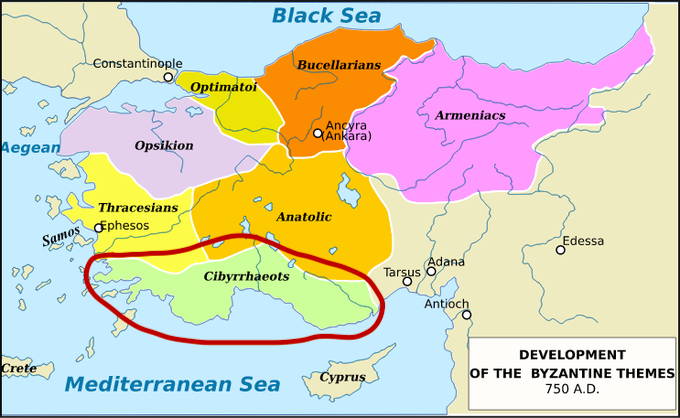
One out of the original Byzantine Themes of Asia Minor was a naval Theme as the rest were land army controlled, this one that was a naval Theme was the Theme of the Cibyrrhaeots (Thema Kibyrrhaioton in Greek). This Theme was first in control of the Karabisianoi, the main Byzantine naval forces and only in around 720 did the main naval force create the Cibyrrhaeot Theme. This Theme originally consisted of the southwest and south coasts of Asia Minor (Mediterranean Turkey) along the Aegean and Mediterranean Seas including the regions of Caria, Lycia, Pamphilia, and parts of Isauria stretching from south of the city of Miletus to the Isaurian Mountains while at the Aegean on the west; this Theme held the Dodecanese Islands and Rhodes, the Theme’s capital was at Attaleia (today’s Antalya, Turkey), overall covering parts of today’s Greece and Turkey including the city of Halicarnassus (Bodrum, Turkey) in Caria. This Theme had a lot of ports, a fleet larger than its army, naval fortresses and bases, and fertile land but because of its geographical position, it was a prime target for raids from the Arab fleets which devastated it and depopulated the countryside many times. This Theme being the naval power of Byzantium provided ships for Byzantine conquests such as in the 911 Cretan expedition where the Theme sent 31 warships with 6,000 oarsmen and 760 marines. With Arab threats lessening, this Theme however lost its importance causing it to be divided into the Themes of the Aegean Sea, Samos, and Seleucia by the late 9th and early 10th centuries. This Theme was partly occupied by the Seljuks in the 1070s but was only dissolved by Emperor Manuel I Komnenos (r. 1143-1180) sometime after the 1150s.
Formed from the Cibyrrhaeots Theme:
Aegean Sea Theme
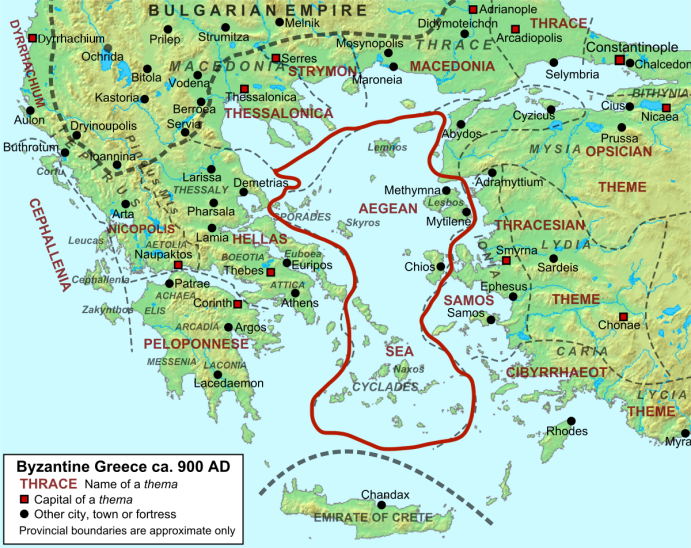
The actual Theme of the Byzantine Empire that controlled the navy and most of their sea territory, which was the Aegean Sea was the Theme of the Aegean Sea (Thema tou Aigaiou Pelagos in Greek) formed by the Byzantine navy in 843 from the Theme of the Cibyrrhaeots which previously had control of the Aegean. The Theme’s capital was Mytilene in Lesbos, the seat of the Strategos but the navy was scattered throughout the islands of the Greek archipelagos in the Aegean Sea including the Sporades and Cyclades; part of this Theme were the islands of Skyros, Lemnos, Lesbos, Chios, and Naxos while Rhodes, Samos, and Euboea were not in this Theme. This Theme however extended all the way north to the entrance of the Dardanelles Strait from the Aegean and in the 10th century it was recorded to have 2,610 oarsmen and 400 marines. The Aegean Sea Theme survived as the major naval supply controlling the middle of the Aegean until 1204 when its islands were divided among the Latin leaders of the 4th Crusade as their territories. The Byzantines were however able to take back control of some of them after 1261 but in 1355, a couple of islands including Lesbos were given to the Genoese Gattilusi family as a Byzantine vassal state.
Theme of Samos

Formed before 899 from the Theme of the Cibyrrhaeots, the Theme of Samos was another Theme of the empire providing its naval supply including sailors which the 10th century emperor Constantine VII records was the major resource of this Theme rather than soldiers. The Theme of Samos was located in the Western coast of Asia Minor (Turkey) in the region of Ionia including the cities of Ephesus and Smyrna which was its capital as well as the Greek islands of Kos and Samos, where the name comes from. Its borders however are not defined as it said that the mainland parts of the Theme belonged to the Thracesian Theme while the Samos Theme consisted of the coast and islands. This Theme was however overshadowed in power by the Thracesian one but it lasted until the 4th Crusade divided the area among the Latin leaders in 1204.
Theme of Seleucia

Seleucia was once an important city in the region of Pamphylia in the southern coast of Asia Minor across Cyprus which in the 8th century fell under the control of the Cibyrrhaeots Theme but in around 927 became its own Theme also a naval Theme being a main supply of warships and despite its size was said to have 10 fortresses and an army of 5,000 in which 500 were cavalry, the capital was of course at Seleucia. This Theme was relatively small in size sandwiched by the Anatolic, Cibyrrhaeots, and Cappadocian Themes with the Mediterranean at the south making it another prime target for Arab fleet raids, although it could be possible that this Theme had administered the regions of Antioch and Aleppo when recaptured by the Byzantines in the 960s. This Theme fell to the Seljuks in the 1070s but was recaptured by the Byzantines in around 1100 until falling to the new Kingdom of Cilician Armenia in 1180.
V. Theme of Thrace
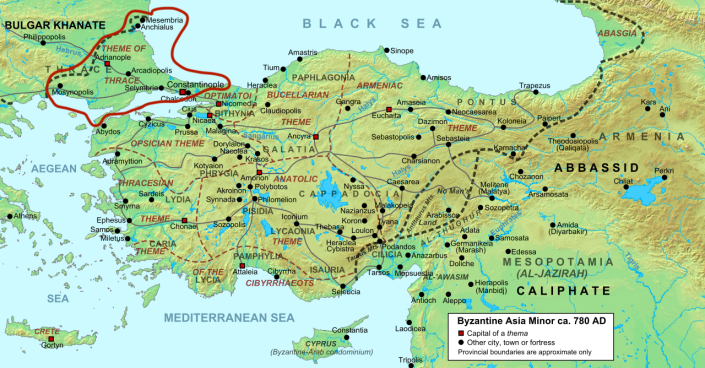
Now onto the original Themes in Europe, and one of the first here to be formed at the same time with the other Themes of Asia Minor was the Theme of Thrace (Thema Thrakes in Greek), created in around 681 around the imperial capital. It is said that the Theme of Thrace was at first was under the command of the Opsician Theme right across it from the Bosporus, although it most likely had its own command as it was a region being enough itself. This Theme was created by Emperor Constantine IV as a defense for Constantinople against the new Bulgar threat which started with the Turkic Bulgar hordes descending into the Balkans; most of it happened to be flat and fertile land compared to the landscapes of Asia Minor. The imperial capital, Constantinople happened to be the capital of the Theme but the one administering the Theme and its army was not the emperor himself but a Strategos as well. This Theme was heavily fortified with 10 forts but only an army of 5,000, though it had the Anastasian Wall which was the first line of defense for Constantinople 64km west of it spanning from the Black Sea to the Sea of Marmara; this Theme today consists of of European Turkey and Southern Bulgaria (Thrace) and its other settlements aside from the imperial capital were the cities of Adrianopolis, Mosynopolis, Bergule, Mesembria, and Selymbria. This Theme’s borders were not defined because of constant Bulgar raids over the years which later caused the Theme to reduce in size with the Theme of Makedonia created in the western part of it, and it was here where the capital of the Thracian Theme was moved to Bergule (also called Arcadiopolis) in European Turkey while Constantinople remained in this Theme too. People living in this Theme were mostly Byzantine Greeks and since the capital was here, it had a large mix of ethnicities but the original people from this Theme were the Thracian people, also it is said that imperial Komnenos family originated here. This Theme eventually decreased in power and by the 11th century it had joined again with the Makedonian Theme but incorporated into it and its end came in 1204 falling to the 4th Crusade, although it would eventually be held by Byzantium again until 1453.
Formed from the Thracian Theme:
Theme of Makedonia
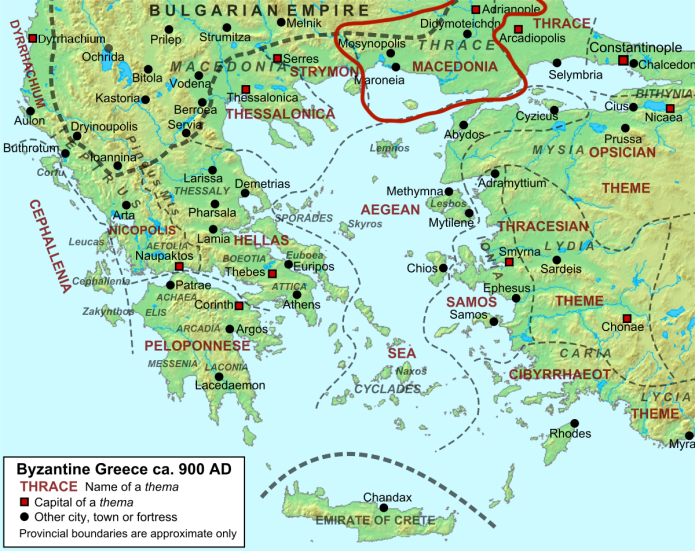
Created out of the Theme of Thrace sometime in the 790s or 800 by Empress Irene (r. 797-802), the new Theme of Makedonia (Thema Makedonias in Greek) consisted of the western part of the Thracian Theme in today’s European Turkey, Northeast Greece, and Southern Bulgaria. The Theme’s name actually happens to have no connection at all to the Greek region of Makedonia and did not even include parts of today’s Republic of Macedonia as the Theme was located in Thrace but had also controlled parts of Greek Makedonia and people in it or its army units were Macedonian Greeks. This Theme was created as a border Theme to further protect Constantinople from Bulgar and Avar raids from the north; when created its capital was the large city of Adrianopolis (today’s Edirne, Turkey) and the Strategos based in it commanded an army of 5,000 together with Tagmatic units. The Theme’s borders in north were undefined until the later part of the 10th century when the emperors John I Tzimiskes (r. 969-976) and Basil II (r. 976-1025) conquered lands north of it creating borders with the new Themes they created while the south of this Theme were both the Marmara and Aegean Seas connected to each other by the Dardanelles Strait and the other cities of the Theme were Didymoteicho, Mosynopolis, Ainos, and Maronia. The emperor Basil I the Macedonian (r. 867-886) came from this Theme born here in 811 and the Macedonian Dynasty which he founded was named after this Theme even if this Theme was located in Thrace, not Makedonia. In around the 11th century, this Theme once again merged with Thrace though the Makedonian one being the one ruling the Theme of Thrace from which it came from and Adrianopolis still being its capital while its fall came in 1204 to the 4th Crusade.
Theme of Strymon
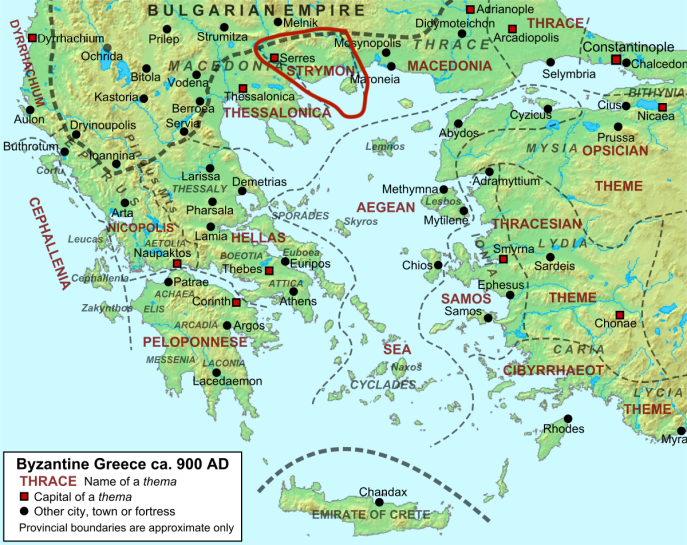
The Theme of Strymon was not formed from the original Thracian Theme but from the Theme of Makedonia that formed from Thrace. This smaller Theme was created in around the 840s as a place to station a fraction of the army from the Makedonian Theme to guard the Byzantium by blocking the mountain passes of the Rhodope Mountains in the north from Bulgar, Slav, and Avar raids. The Strymon Theme was a small but strategically important one as it not only controlled the mountain passes but had the Roman highway of the Via Egnatia that connected Makedonia and Thrace; this small piece of land in Northern Greece was bordered by the Strymon River in the west where its name is derived from, the Nestos River in the east, the Rhodope Mountains in the north, and the Aegean Sea in the south. Today, this Theme is located in the narrow northeast Greece while its capital was the city of Serres in Greek Macedonia and the people living in it were Macedonian Greeks but mostly Slavs who settled in the area. The Theme of Strymon continued to exist though with border changes until the 4th Crusade took it in 1204 putting it under the Kingdom of Thessalonica which was captured in 1246 by the Empire of Nicaea putting it later back in Byzantine control until it was permanently dissolved in 1345 by the invasion of Stefan IV Dušan’s Serbian Empire while the 1341-1347 Byzantine Civil War was happening.
VI. Theme of Hellas
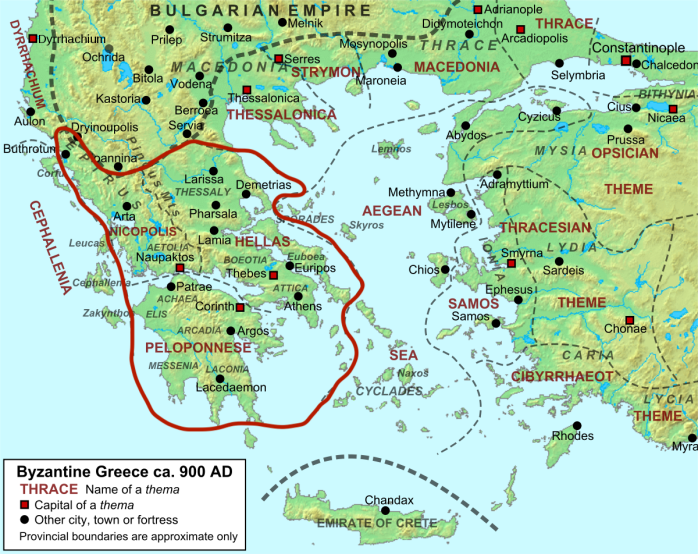
As early as the first reign of Justinian II (685-695), the historically significant mainland of Greece too was made into one of the empire’s original Themes, which was the Theme of Hellas (Thema Hellados in Greek) and in the 7th and 8th centuries, this Theme covered a large amount of land encompassing almost the entire Greek mainland from the Pindus Mountains and the plains of Thessaly in the north to the Peloponnese Peninsula in the south including islands close to the Greek mainland like Euboea while its capital was at Thebes in Boeotia. This Theme was created to strengthen the protection of Byzantine controlled Greece from Slavic raids coming from the north, which had previously taken most of Greece until this Theme was created to block of the Slavs, however its borders in the north were not defined because of the constant Slavic raids. The Theme of Hellas originally consisting of a large landmass had varied landscapes including coastal areas, mountains, plains, lakes, and hills which is basically the landscape of Greece- in which you can see in the game Assassin’s Creed Odyssey how it looked like in the ancient days. The Theme of Hellas was highly and densely populated as it had many cities including Athens, had an army large in number, and by having the sea it controlled a large fleet, however by the beginning of 10th century, the Theme of Hellas was reduced to the east of central Greece with Thebes still as its capital and near it the iconic Monastery of Hosios Loukas but still including flat and fertile Thessaly, hilly Boeotia, rocky Attica, and the island of Euboea as well as Athens while the Themes of the Peloponnese, Nicopolis, and Cephallenia were created out of it. This Theme had faced countless enemy raids over the years by Slavs, Arabs, Bulgars, and Normans but it still remained highly populated and prosperous according to 12th century Spanish-Jewish traveler Benjamin of Tuleda and Sicilian-Arab geographer Al-Idrisi. The end of this Theme came with the 4th Crusade in 1204 after diving the land creating the Latin Duchy of Athens and Venetian controlled Euboea.
Formed from the Theme of Hellas:
Theme of Cephallenia

The islands in the Ionian Sea, off the west coast of mainland Greece became its own Theme, the Theme of Cephallenia or Cephalonia (Thema Kephalonias in Greek) by the mid-8th century but was only recognized as a full Theme with a Strategos during the reign of Emperor Leo VI the Wise (886-912). This Theme was basically a maritime Theme used as a Byzantine naval base in the Ionian Sea as well as to keep the ships travelling from Byzantine held Italy to Greece and vice-versa safe from Arab pirates. This Theme basically held the islands of Corfu (Kerkyra in Greek), Lefkada, Cephalonia, Ithaca, Zakynthos while the capital was at Cephalonia; although this Theme primarily controlled the Ionian Islands, the island of Kythira all the way below the Peloponnese was controlled by this Theme. This Theme’s army wasn’t so large only having 2,000 but its navy was stronger while its islands were usually used as places of exile for political prisoners. Byzantine control of this Theme came to an end in 1185 when it was captured by the Norman armies of Sicily under their king, William II (r. 1166-1189), although only Corfu was recaptured by the Byzantines in 1191 but the rest had been lost.
Theme of Langobardia
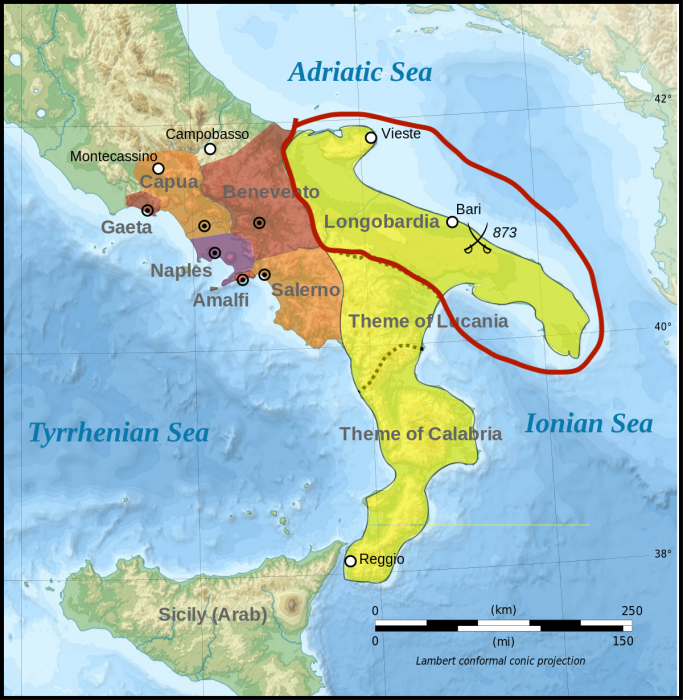
Meanwhile in Italy, the Byzantines for a long time held most of the peninsula controlled by the Exarchate based in Ravenna which however fell to the Lombards in 751 forcing the Byzantines to retreat to Southern Italy. Once the Byzantines were left with Southern Italy, the eastern Peninsula or the region of Apulia was formed into the Theme of Langobardia in around 891 from the armies of the Theme of Cephallenia across the Ionian Sea in order to protect Byzantine Italy from the raids of the Arab fleets. The Theme’s name comes from the Lombard people who had settled here and beyond this Theme. The Theme’s capital was Bari (Barion in Greek) while it also controlled the Apulia region and the cities of Taranto, Brindisi, Otranto, and Gallipoli but this Theme did not last that long as it was joined with the neighboring Themes of Lucania and Calabria to form the Catepanate of Italy in 965.
Theme of Nicopolis

While the Theme of Cephallenia controlled the Ionian Islands across the western coast of Greece, the Theme of Nicopolis controlled the western part of central Greece which includes the regions of Epirus and Aetolia. The Theme of Nicopolis was established sometime after 886 from the larger Theme of Hellas while the Strategos of this new Theme was based in Naupaktos, the capital along the Gulf of Corinth. This Theme was created to strengthen the protection of Greece especially from Bulgar raids from the north during the late 9th century; this Theme’s north border was however undefined but could be the Albanian-Greek border and it was bordered by the Ionian Sea in the west, the Pindus Mountains in the east, and the Gulf of Corinth in the south while its other cities included Arta and Actia Nicopolis where the Theme’s name came from; this was also where the historic Battle of Actium (31BC) during the end of the Roman Republic. This Theme’s army was however small only consisting of 1,000 men in the 10th century but its fall only came in 1204 to the 4th Crusade but in 1205, it became the core area of the new Byzantine State known as the Despotate of Epirus with Arta as its capital.
Theme of the Peloponnese

To further strengthen Greece, the original Byzantine Theme of Hellas created the Theme of the Peloponnese in the large southern peninsula of Greece known as the Peloponnese in around 800 by establishing military units there after this area was freed from Slavic occupation. The Peloponnese consists of varied landscapes including fertile plains, swamps, mountains, and coastal areas and this Theme was large enough to control the Peloponnesian Greek regions of Corinth, Argos, Achaea, Arcadia, Elis, Messenia, and Laconia. The Theme’s capital was at Corinth, which was an important Ancient Greek and Roman port city in the northern coast of the Peloponnese along the Gulf of Corinth while other cities it controlled were Argos, Patras in the north coast, and Sparta in the southeast although it was controlled by a strong Byzantine Greek army and had many fortresses built over Ancient Greek ones, Slavs were also a major population here. The Peloponnese remained strongly under Byzantine control as it had also controlled the navy and it only fell in 1204 when the Latins divided the empire among themselves after the 4th Crusade whereas the Peloponnese fell to the Duchy of Achaea and with Byzantium restored later on, the Byzantine Despotate of Morea controlled based in the new city of Mystras near Sparta brought back Byzantine control to the Peloponnese.
Themes Created as New Territories
Present countries under the area of the Themes created as new territories of Byzantium: Ukraine, Croatia, Albania, Montenegro, Malta
The Anatolic, Armeniac, Opsician, Cibyrrhaeot, Thracian, and Hellas Themes were the original Themes of the Byzantine Empire and under them several Themes were formed as I have mentioned. However in the 8th, 9th and 10th centuries, there were 9 other Themes that were not created from the territory of other Themes but rather by the expanding territory of the Byzantine Empire taken by conquests or by newly formed army units.
Theme of Cherson

The peninsula known as the Crimea north of the Black Sea, now part of Ukraine and Russia had once been under Roman and Byzantine control, though not the entire peninsula until it fell to Khazar control in the early 8th century. Shortly before it fell to the Khazars of Russia, the deposed Byzantine emperor Justinian II who’s nose was cut off was exiled here in 695 and from here he gathered strength to take back the throne in 705 but back in Cherson, the general Philippikos Bardanes who Justinian II exiled to Cherson raised his rebellion there to successfully overthrow Justinian II again in 711 and ruling until being overthrown in 713. Shortly after however, the area fell to the Khazars until taken back in the 830s by Emperor Theophilos who had interest in the northern coast of the Black Sea for relations with the Khazars and to establish a Byzantine naval base to protect the Black Sea against raiders from the north. Cherson remained an important buffer zone and diplomatic center between the Byzantines and the people in the north from the Khazars, to the Kievan Rus, to the Pechenegs and also here, the city of Cherson which was the capital was a thriving Byzantine trade and port city. The Theme however was only the southern coast of the Crimea including a few other settlements which includes today’s Kerch and Yalta where you can still find some Byzantine era fortresses and under the Byzantines, Cherson was a powerful Theme despite its distant location as it for a long time minted its own coins as it was for a long time the only provincial mint outside Constantinople. The Theme of Cherson was absorbed into the Empire of Trebizond which formed in 1204 from the aftermath of the 4th Crusade; this has then been the Byzantine Empire’s northernmost location.
Theme of Crete

The large island of Crete, which was once home to the ancient Minoan civilization in the Mediterranean south of Greece and north of Egypt had been a Roman province joined with Cyrenaica in North Africa before falling under the eastern half of the Roman Empire or the Byzantine Empire in 395. For many centuries, Crete remained under Byzantine rule but there is not much record of early Byzantine Crete until the conquest of the Arabs from Muslim Spain in the 820s. Once the large groups of exiles from Muslim Andalusia in Spain occupied Crete, the Byzantines have had many failed attempts to take it back while the occupiers made the city of Chandax their capital turning Crete into an emirate. The Emirate of Crete however did not last very long as in 961, the Byzantine general, Nikephoros Phokas who later became emperor successfully stormed Chandax with a huge army and restored Crete to Byzantine rule. Once again under Byzantine rule, Crete became its own Theme with a Strategos based in Chandax (today’s Heraklion) which remained as its capital while being in the middle of the Mediterranean it controlled a strong navy. The Theme primarily consisted of the dry and rocky island of Crete and possibly the island of Thera (Santorini) which was close but the second period of Byzantine rule was a relatively peaceful time; the Byzantines here at this time carried out missions in converting the former Muslim population to Christianity and reconverting the Greeks that had been Christian long before. The Byzantines would permanently lose Crete in 1205 to Venice when the 4th Crusade divided the regions of Greece among Latin powers.
Theme of Dalmatia

The Dalmatian Coast along the Adriatic Sea in Croatia had once been the Roman province of Dalmatia controlling Croatia and Bosnia until falling to the Ostrogoth Kingdom in 476 but was recaptured and added to the Eastern Roman Empire (Byzantine Empire) by Emperor Justinian I in the 530s. However, because of Slavic raids from the east, most of Byzantine territory in Croatia and Bosnia were lost limiting their control only to the islands off the coast and the coastal cities of Spalatum (Split), Ragusium (Dubrovnik), and Jadera (Zadar). In around 800, the first Holy Roman emperor Charlemagne seized Dalmatia but restored it to Byzantium in 812 to make peace with them but it was only in the 870s where Dalamtia was made into a Byzantine Theme under Emperor Basil I the Macedonian to strengthen Byzantine hold in the northern Adriatic, the Theme’s capital had then been in Zadar which the Byzantines called Idassa. The Byzantine army and navy however only held on to the coastal areas of Dalmatia and its islands as most of the land was lost to the new Croat Kingdom and the Serb principality of Dioklea. In the 1060s, Byzantine control collapsed in Dalmatia being too difficult to defend against invaders which limited Byzantine control to the southern part of it while the north fell to the Kingdom of Hungary; however the Byzantines would for a while restore their hold in Dalmatia during the reign of Manuel I Komnenos (1143-1180) but after his death, the Dalmatian coast fell to Venetian control while the inland parts fell to the rising Serbian kingdom.
Theme of Dyrrhachion

Now to Albania, the Adriatic coast of it and some inland parts reaching up to today’s Montenegro as well fell under the control of the Byzantine Theme of Dyrrhachion sometime during the reign of Emperor Nikephoros I (802-811) to protect the Byzantine cities along the coast of Albania from the expansion of the First Bulgarian Empire in the east. By 900, this Theme was located north of the Theme of Nicopolis and south of the Theme of Dalamtia, bordered in the east by the Serb principality of Dioklea and parts of the First Bulgarian Empire including the city of Ohrid while this Theme mainly consisted of mountainous and fertile Albania together with the coast where its capital, the port city of Dyrrhachion (Durres, Albania) is located, which was the birthplace of the early Byzantine emperor Anastasius I Dicorus (r. 491-518) sometime in the 430s. This Theme was inhabited by Byzantine Greeks and the local Albanian (Illyrian) tribes and had a key role in Byzantine history playing a key role in the Byzantine-Norman Wars as it was where the Battle of Dyrrachion in 1081 took place which resulted in the loss of Albania to the Normans until Emperor Alexios I Komnenos took it back for Byzantium in 1084. Byzantine rule in Albania (Theme of Dyrrhachion) ended in 1205 when Dyrrhachion surrendered to the Venetians following the 4th Crusade.
Theme of Lykandos

In the eastern edge of Asia Minor along the empire’s mountain borders, the new Theme of Lykandos was created in 903 by Emperor Leo VI the Wise to continue guarding the eastern Antitaurus Mountains border from Arab invasions. This Theme was however small in size and only important militarily as a frontier zone between the Byzantine Empire and the Emirate of Syria while most of its inhabitants were soldiers and its capital was the Fortress of Lykandos; the Theme’s location is in today’s Eastern Turkey. The Theme of Lykandos survived up to the 1070s when this area along with many others in Asia Minor fell to the Seljuks.

Theme of Mesopotamia

The Theme of Mesopotamia’s name is confusing as it was not located in the ancient region of Mesopotamia between the Euphrates and Tigris Rivers in Iraq where the first civilizations began and had also been a Roman province for a time but in an area not too distant from it in Eastern Turkey; its name came from its location between the Murat and Cimisgezek Rivers as “Mesopotamia” means “the land between rivers” in Greek. This Theme was created sometime between 899 and 911 during the reign of Leo VI the Wise, formed out of land from the former Armenian principality of Takis and in exchange for this land in Eastern Asia Minor; the Armenian prince was given estates in the other Themes in Asia Minor. This small Theme was based in the city of Kamacha (now Kemah, Turkey), had an army strong enough to defend the border, and had a large Armenian population. This Theme had also met its end to the Seljuks in the 1070s. This area is also where the district of Agel is located, the place said to have been the origin for the name of the Angelos Dynasty (1185-1204).
Theme of Phasiane
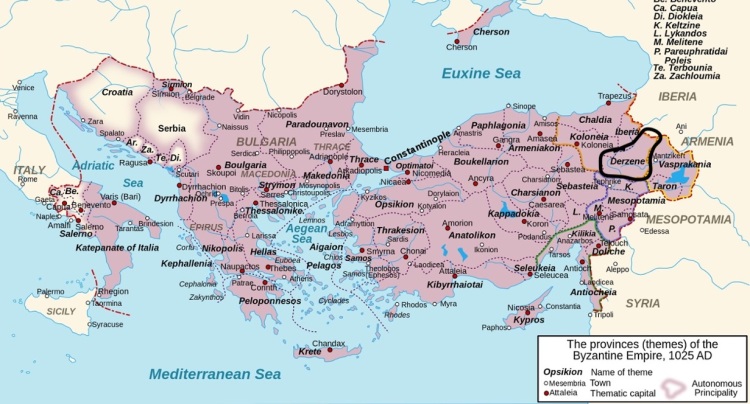
In the late 10th century, a region in Northeast Asia Minor bordering with Armenia known as Phasiane or Basiani ceded to the Byzantine Empire after centuries of Armenian rule following the death of an Armenian noble. Back in the 3rd century, this land was contested between the Roman and Sassanid Persian Empires but once it came under Byzantine rule under Emperor Basil II (r. 976-1025), it was organized into a Theme until joining into the larger Theme of Iberia organized by Basil II in 1001 to serve as a buffer state between Byzantium and the Kingdom of Georgia during times of war between them. The Theme of Phasiane’s capital was at Arsamosata near the Upper Euphrates River and the Aras River that broders Turkey and Armenia, many of its inhabitants were Armenians as well. In 1048, this Theme’s armies together the Georgian armies successfully defeated one of the early raids of the Central Asian Seljuk Turks but in the 1070s it still fell to the Seljuks though sometime later reclaimed not by Byzantium but by the Georgian kingdom.
Theme of Sicily
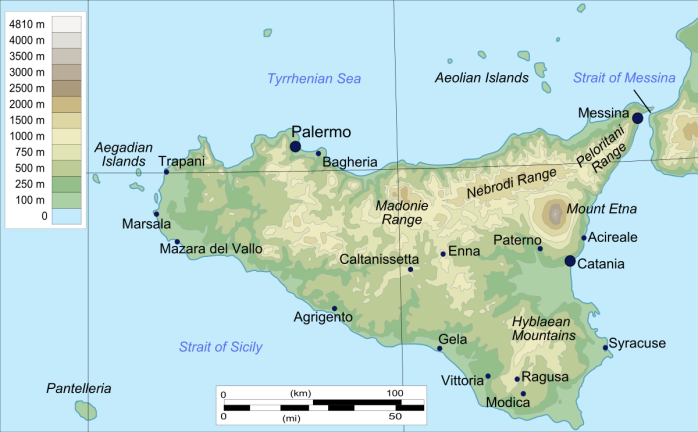
Before the Reconquest of Italy in the 530s by the general Belisarius under Emperor Justinian I, Sicily was under the Ostrogothic Kingdom but with Byzantine control established, the island of Sicily was placed under the control of a military governor. In the 660s, when Constantinople was in the threat of being invaded by the Arab fleet, the emperor Constans II (r. 641-668), fled to Sicily and never returned to Constantinople thinking about moving the capital to Syracuse until he was assassinated in his bath in 668 and afterwards Constantinople still remained the capital. After this emperor’s death however, the Byzantines still held Sicily and by the 680s organized it into a smaller Theme to protect Italy from Arab raids coming from the sea. The Theme of Sicily (Thema Sikelias in Greek) had its capital in Syracuse and consisted of the entire island of Sicily and Malta and having other important cities such as Katàne (Catania), Tavromenion (Taormina), Panormos (Palermo), Argrigento, and Marsala and had a population of Greeks and Italians. With the Byzantines, Sicily prospered and many Byzantine landmarks including churches with mosaics were built but by 878, Syracuse fell to the Arabs and by 902, the Arabs captured Taormina ending Byzantine rule in Sicily, thus its Strategos moved to Calabria in the mainland where the Sicilian Theme was transferred to, although the Byzantines would later have many failed attempts to take back Sicily from the Arab Emirate, which later fell to the Normans in 1071.
Theme of Thessalonica
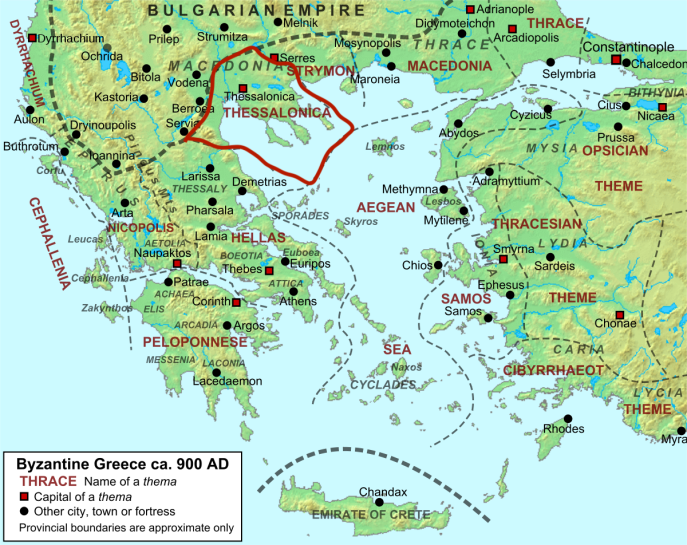
Thessalonike in the northern Greek region of Makedonia was the Byzantine Empire’s 2nd most important city after Constantinople and had once been the capital of the Roman province of Macedonia then in the early 800s, the city and the region around it became its own Byzantine Theme to enhance Greece’s defense from the Bulgars, based in the city of Thessalonike itself. The Theme was bordered in the north by the Rhodope Mountains as a natural barrier against Bulgar invasions, the Theme of Hellas to the west and the River Strymon to east in which across it was the Theme of Strymon while the southern border of this Theme was the Aegean Sea. This Theme includes today’s region of Makedonia in Greece where the city of Pella, once the capital of Alexander the Great’s Macedonian Empire (4th century BC) and the 3 peninsulas of Chalcidice where the monasteries of Mt. Athos were built in the 10th century. The Theme of Thessalonica was an important Theme but it was lost to the 4th Crusade in 1204 becoming the Kingdom of Thessalonica until it was captured by the Despotate of Epirus in 1224, then by the Empire of Nicaea in 1246 returning it to Byzantine rule, and then becoming Byzantine despotate in 1402 until surrendering to Venice in 1423 and finally falling to the Ottomans in 1430.
Newer Themes
Present countries under the area of the Themes created as newer territories of Byzantium: Georgia, Cyprus, Republic of Macedonia, Kosovo, Serbia, Bosnia
After the 10th century, continuous conquests by the Byzantine Empire and additional need for protection from external threats made the empire create both large Themes and small frontier Themes in the Balkans, Italy, and Asia Minor from the 10th to 13th centuries. Many of these Themes were very small in size and only used as military bases to protect the borders and information about them is very limited.
Artze- In the 970s, the Byzantines created the minor Theme based in the city of Artze in Eastern Asia Minor after additional minor conquests but in 979 was ceded to the Georgian principality of Tao but after its king’s death in 1000, it returned to Byzantine control ending up in the Catepanate of Iberia, though the city of Artze was destroyed by the Seljuks in 1049.
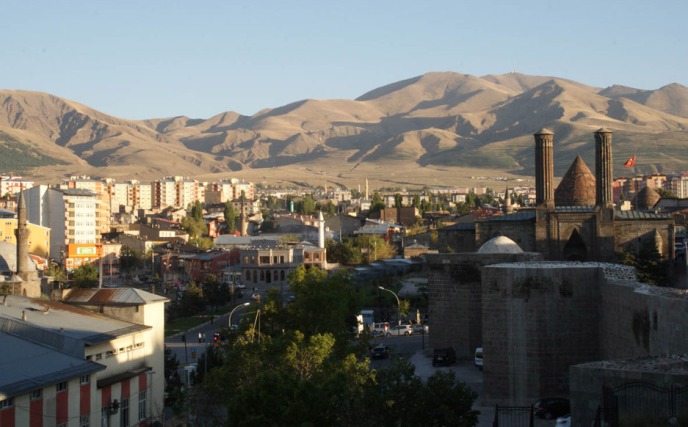
Asmosaton- A minor Theme created in the eastern border of Asia Minor by the Byzantine army in 938 which survived until falling to the Seljuks in the 1050s. (no related picture or map for this Theme).
Bulgaria- Following the defeat of the First Bulgarian Empire in 1018 by Emperor Basil II, what was once the empire of the Bulgarians was organized into one large Byzantine Theme (Thema Boulgarias in Greek) administered in the city of Skopje in today’s Republic of Macedonia- near the birthplace of Emperor Justinian I in 482- while today’s Bulgaria only happened to be part of this Theme which covered a vast amount of land bordered in the south by the Greek Themes of Thrace, Makedonia, Strymon, and Thessalonike, north by the Danube River, stretching east to today’s Bulgaria, and west to the Themes along the Adriatic Coast ;it includes today’s Bulgaria, Republic of Macedonia, Kosovo, and Southern Serbia. In Byzantine Bulgaria, the Bulgarian patriarchate was reduced to an archbishopric based in Ohrid and the power of the Bulgarian aristocracy was limited and replaced by the Byzantine government. This Theme lasted through the 11th and 12th centuries but had faced many raids by the Cumans and Pechenegs while its end came in 1185 when the Asen brothers led the Bulgarian people to a large rebellion against the Byzantine emperor Isaac II Angelos (r. 1185-1195), thus declaring Bulgaria’s independence from Byzantium and the 2nd Bulgarian Empire.

Calabria and Lucania- Once Sicily fell to the Arabs in 902, the Byzantine Theme there was moved to the Peninsula of Calabria in mainland Italy where the its Strategos was based in Rhegion (Reggio Calabria) across the strait from Sicily. While Calabria became its own Theme, the land north of it and south of Apulia known as Basilicata became the Theme of Lucania in 968 which included Tursi, the Theme’s capital and the city of Matera while its inhabitants were both Byzantine Greeks and Lombards. Even though Lucania, Calabria, and Langobardia (Apulia) were its own Themes, they had been administered by the larger Catepanate of Italy based in Bari which fell to the Normans in 1071.

Charpezikon- This had only been created as a minor Theme in 949 based in a fortress with the same name Located in Eastern Asia Minor east of the Euphrates River and only had been a small frontier Theme with a garrison of only 905 men. (no related picture or map for this Theme).
Chavzizin- After 940, a minor Theme with the name Chavzizin which was probably an Armenian name was established in the Bingöl Dag Mountains of Eastern Asia Minor which does not have much record about its borders, army, inhabitants, and when it fell, although it most likely fell to the Seljuks in the 1070s.

Chozanon- Around the city of Hozat in Eastern Asia Minor, the Byzantines sometime in the 950s established the Theme of Chozanon based in this city as base for their additional army in Asia Minor, its fall however is not recorded.

Cyprus- When the Roman Empire was divided in 395, Cyprus in the Eastern Mediterranena fell to the Eastern half which became the Byzantine Empire and from 688, the island of Cyprus was an Arab-Byzantine Condominium where both Arabs and Byzantines shared their rule over it. In 965 however, the Byzantine army led by the general Niketas Chalkoutzes under Emperor Nikephoros II Phokas took the entire island for themselves establishing it as a Theme in which its capital was Leukosia, now Nicosia which is Cyprus’ capital. In 1185, the governor of this Theme, Isaac Komnenos rebelled to claim the empire for himself but in 1191 he surrendered the island to King Richard I the Lionheart of England or else be invaded by the Crusaders, but in 1192, control of Cyprus passed from Richard the Lionheart to the French Crusader Guy de Lusignan establishing his kingdom there.
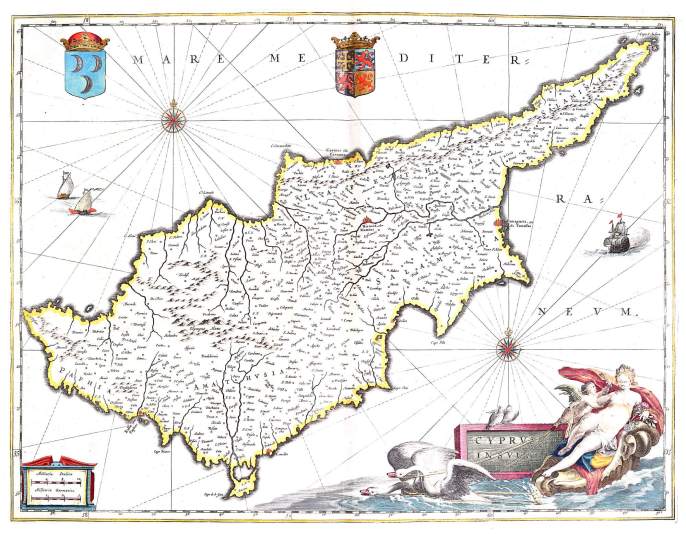
Derzene- This was only a minor Theme used as an army base formed in around 952 which had only consisted of the surroundings of the town of Tercan in the arid northeast of Asia Minor while the Theme itself was administered by the Theme of Chaldia based in Trebizond along the Black Sea.
Edessa- In 1032, Byzantine territory extended to Southeast Asia Minor creating a few new Themes including the small frontier Theme of Edessa based in the ancient city of Edessa itself today near Turkey’s border with Syria situated in a fertile valley of the Taurus Mountains. Edessa had once been under Byzantine rule until 638 when it fell to the Islamic Rashidun Caliphate but in 1032 taken back by the Byzantines until it fell to the Seljuks in 1086.
Hexapolis- In the 970s, the minor Theme of Hexapolis in Eastern Asia Minor was created as a frontier Theme between the Themes of Lykandos and Melitene; its name means “6 villages” as it was built on 6 villages, though there is not much record about this Theme and when it fell.
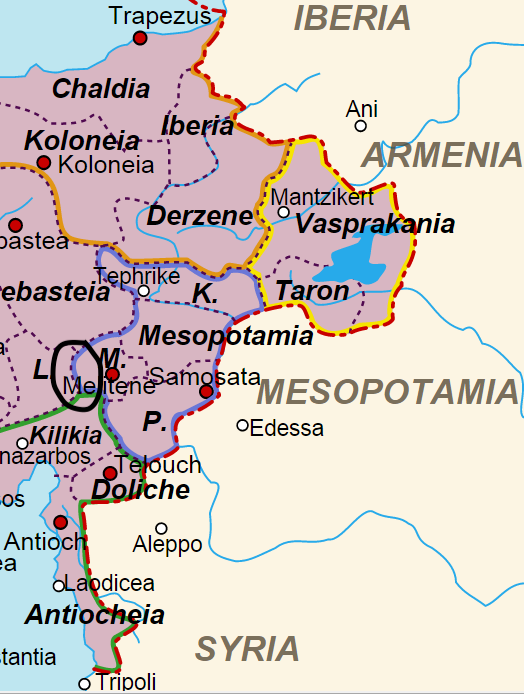
Iberia- Having the same name as the peninsula of Spain and Portugal, the region between Turkey and Georgia was known as Iberia which had been under the Georgian kingdom until annexed to Byzantium by Emperor Basil II 1001. This Theme occupied a small part of northeast Asia Minor and was based in the city of Theodosiopolis but was only under the Byzantine control of the Catepanate of Iberia until falling to the Seljuks in 1074 and afterwards was absorbed into the Bagratid Georgian kingdom.

Maeander- When the exiled Byzantine Empire of Nicaea was created in 1204 from the aftermath of the 4th Crusade, a minor Theme was created by them also in 1204 along the Meander River in Western Asia Minor but was shortly after absorbed into the surviving Thracesian Theme which was under Nicaea.
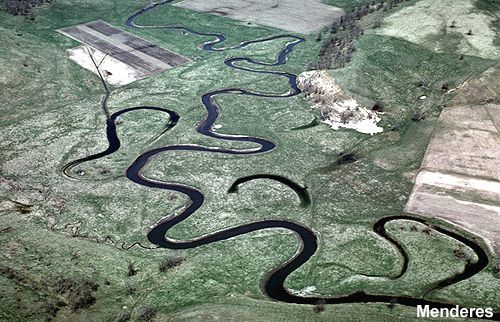
Manzikert- Part of the territory annexed from the Georgian kingdom to Basil II’s Byzantium in 1000 was the area around Lake Van in Eastern Asia Minor in which was organized into the small frontier Theme of Manzikert based in the city of Manzikert. In 1071, the decisive Battle of Manzikert happened outside the city where the Byzantine army of Emperor Romanos IV Diogenes lost to the invading Seljuk Army of Alp Arslan, afterwards this was the first theme to fall to the Seljuks and the rest in Asia Minor followed after this.
Melitene- When Byzantine territory expanded to the southeast of Asia Minor, a new Theme was created around the city of Melitene in 970 under Emperor John I Tzimiskes as a frontier Theme. There is not much record about this Theme and when it fell but today, Melitene is the city of Malatya in Turkey.
Mylasa and Melanoudion- Before 1143, the Theme of Mysala and Melanoudion was created after Emperor John II Komnenos (r. 1118-1143) recaptured territories in Asia Minor taken by the Seljuks earlier built on the are where the Cibyrrhaeot Theme existed before, which was the region of Caria in Asia Minor along the Aegean Sea. Originally it was called the Theme of Mylasa based in the city of Milas and it occupied the part of the region of Caria along the Meander River and it was later joined with the island of Kos in the Aegean off the coast of Asia Minor. In 1204, this Theme remained under the control of the Empire of Nicaea but its capital was moved to Melanoudion and remained a Byzantine Theme until its fall to the Ottomans sometime during the reign of Andronikos II Palaiologos (1282-1328).
Neokastra- According to the historian Niketas Chonaites, the emperor Manuel I Komnenos created the new Theme of Neokastra sometime between 1162 and 1173 in the northern part of the Thracesian Theme in northwest Asia Minor- the area of today’s Pergamon and Adramyttion- to further strengthen the region. Its name means “new fortress in Greek” and as a result of 1204, this Theme remained under the control of the exiled Byzantine Empire of Nicaea.
Paristrion- In the 970s, the emperor John I Tzimiskes conquered a part of Bulgaria along the south banks of the Danube and probably created the Theme of Paristrion around this time based in today’s Silistra in Bulgaria, then called Dorostolon. This Theme would be located in the northernmost part of the empire along the Danube borders once the Bulgarian Empire was defeated and the Bulgarian Theme established in 1018. After 1018, this would be a large Theme stretching north from the Danube south to Thrace and bordered by the Black Sea in the east and the Theme of Bulgaria in the west. This Theme however was a prime target for the Cuman and Pecheneg armies and by the late 12th century, and in 1185, the rebellion of the Asen brothers began in this Theme at the city of Tarnovo which led to Bulgaria’s separation from Byzantium and the birth of the 2nd Bulgarian Empire.
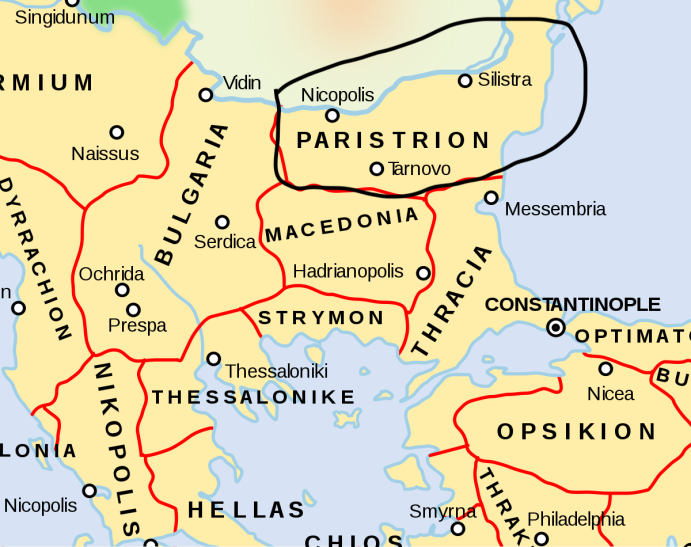
Samosata- In the southern part of today’s Turkey near the border with Syria was once the ancient city of Samosata dating back to the 3rd century BC which today, its ruins were taken over by the Ataturk Dam but a small town nearby called Samsat took the place of the ancient city. In 958, Samosata became the seat of the frontier Theme with the same name where its Strategos was based in after Byzantine conquest of the area from the Arabs. There is not much record though on the Theme of Samosata and the Byzantine history of it as well as when it fell.
Sirmium- Serbia had once been under Byzantine in the early days of the empire but had only become a Theme called the Theme of Sirmium after the conquest of the First Bulgarian Empire in 1018, which made the emperor Basil II create a Theme with the city of Sirmium in Serbia as the capital. This Theme was a large one covering most of today’s Serbia, Bosnia, and Kosovo including the cities of Belgrade and Nis which was the birthplace of Byzantium’s first emperor Constantine the Great in 272. This Theme existed with its neighboring Serbian principalities but its collapse came in 1071 when Byzantium faced the disaster at Manzikert allowing the Hungarian Kingdom to take advantage of the situation and take over this Theme which returned to Byzantine control in the 12th century but this period was short as the Serbian states would emerge form its own principality in this region dissolving the Theme.
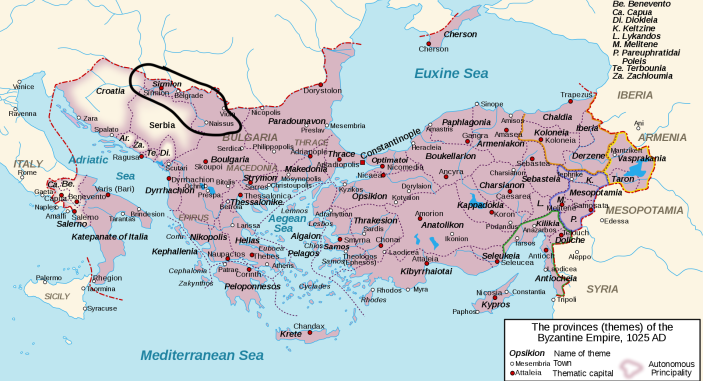
Taron- Sometime around 966, the small Theme of Taron was created as an additional base for the army somewhere east of Lake Van in Eastern Asia Minor, although there is not much record about this Theme except that it was one of the first to fall to the Seljuks in 1071 due to its proximity to Manzikert.
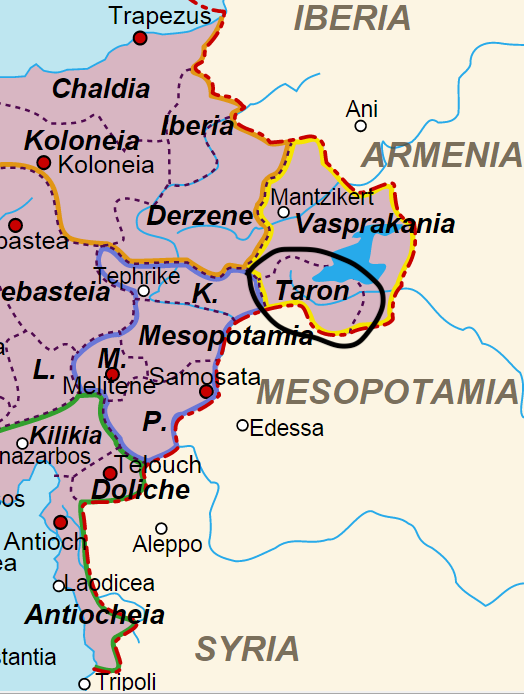
Tephrike- Now the town of Divrigi in the Sivas Province of Eastern Turkey, the stronghold of Tephrike was in Byzantine times a stronghold for the Paulician heretics who separated from the empire until the fortress was taken from them by the Byzantine army in the late 9th century where the army made it their base. In around the 930s, the area around the fortress which was renamed Leontokome became a Theme which survived until being conquered by the Seljuks in 1071.
Vaasprakania- Now to the last Theme in this article which was located in the east of Lake Van in Eastern Turkey which until 1021 belonged to the small Armenian kingdom of Vaspurakan until its king ceded his realm to the Byzantines in around 1021. This area east of Lake Van was governed as a Byzantine Theme for only 50 years until the Seljuks captured it following Manzikert.
Great reforms are usually created from great challenges, and in the case of Byzantium in the 7th century, this great period of a large scale imperial challenge created an ultimate reform which was to minimise the empire’s size and provinces to be able to be administered in an easier way. The 7th century saw a major turning point for the Byzantine Empire as it suddenly came to the point when its borders rapidly decreased from controlling borders as far as the Sahara Dessert in North Africa and the Middle East in the east, its borders shrunk to the eastern edges of Asia Minor losing many of the old provinces, thus minimising the control of the army to smaller areas. During the reign of Justinian I, the Byzantine Empire reached its maximum extent all the way to Spain in the west but the massive size of the empire only became to expensive and difficult to maintain, thus causing in the overthrow and execution of the emperor Maurice in 602 for not paying the army to constantly defend the borders, and this overthrow resulted in the beginning of Byzantium’s decline as invaders came in from all sides. The reign of Heraclius (610-641) however made Byzantium powerful again after ending the centuries long war with the Sassanid Persian Empire in 628 but the end was still a tragic one as the Arabs from the south came in massive numbers quickly taking away Byzantium’s wealthiest and most populous eastern provinces such as Egypt and Syria, thus reducing the borders of Byzantium all the way up to the point of laying siege to Constantinople, the capital. The one person who can be thanked for saving Byzantium from an earlier collapse in the emperor Constans II (r. 641-668) who despite being paranoid of an Arab invasion of Constantinople resulting in fleeing to Sicily attempting to move the capital there only to be assassinated by a slave wielding a soap dish, he saw the right solution that would evenly distribute the army by creating smaller provinces that would recruit and locally and tax a smaller area to fill the imperial treasury with the absence of the former wealthy provinces that had fallen and had never again been reclaimed by the Byzantines. Constans II still remains one of the more obscure Byzantine emperors but his legacy of creating the Theme system was one that lasted for centuries and helped the empire live much longer; although it was not entirely the emperor himself that created this system but his generals and this system could have even been proposed back in the reign of Heraclius, Constans II’s grandfather. Whatever the origins story of the Themes were, this system proved to be effective and despite being troublesome in rivalling with each other, or worse making alliances to support one another in overthrowing the ruling emperor at Constantinople, the division of land into military controlled provinces helped prevent the borders from falling with the presence of fortresses along the borders, and yet even helped strengthen the military of the empire, that by the 10th century, its borders once again expanded up to the point of once again becoming a powerful empire controlling Asia Minor, the Balkans, the Eastern Mediterranean, and Southern Italy. These Themes however would not exist for a long time in its original size as changes in the economy, need for more armies, or the decrease of power for generals cause the original Themes to be divided and decrease in size while new conquests led to the creation of new Themes. Byzantium would however never be as powerful and large as it was in the 6th century with Justinian I as emperor but it still survived for 8 more centuries because it never gave up it protecting itself, and establishing the Themes was a major way Byzantium had in securing the empire from constant invasions from all directions. By 1025, the Byzantine Empire had almost 40 Themes as it was once again large in size and a powerful force, thanks to the emperor Basil II (r. 976-1025), but after his death, a period of increased decline once again took place and many Themes were lost, especially those in Asia Minor which collapsed after the Seljuk Turks from Central Asia defeated the Byzantines at Manzikert in 1071 leading to the conquest of most of Asia Minor. The Byzantines still managed to rebuild itself with reconquests under the Komnenos emperors (1081-1185), but this golden age again did last as one fatal event changed everything, the 4th Crusade of 1204 which divided Greece among the Latin conquered forcing the Byzantines into exile until they were able to overcome the Latins and regain their empire in 1261, but no longer having the old glory they once had. At this time, the Theme system would come to its total collapse as the empire was reduced only to Constantinople, some islands, and parts of Greece which were too small to be controlled as military provinces, thus the population having been reduced as well. Like every empire, Byzantium did not last forever as it fell to the Ottomans in 1453 but because of its alertness to invaders and strategic decisions, the empire lasted for 1,100 years. Having existed that long also meant that many things had changes from the way they were in the times of Constantine the Great and Justinian as Byzantium still remained as the continued Roman Empire but they no longer spoke Latin but instead Greek, names had become Greek, and fashion and customs had become more eastern while Byzantium also chose to remain the way they were when they were still advanced compared to the rest of Europe in the time when Europe had become more modern, thus making the Byzantines become backwards and the opposite of what they were before. Anyway, the Themes and their stories show how Byzantium managed their empire and adapted to new systems when things had changed as population in those areas began to grow in number compared to how it was in the time of the Roman Empire and how they managed to change the organisation of their armies and taxes in order to keep the empire growing. This Theme system of Byzantium is quite similar to Feudalism in Western Europe except that in the Byzantine Empire, powerful landlords did not control the Themes but instead the generals and their armies who did not inherit the land from their fathers but were appointed by the emperors to protect it while people living in them were required to support the army with the resources they could produce as well as be trained as soldiers despite being farmers or ordinary people as invasion could happen at any time. The creation of the Themes then had signalled the beginning of the Byzantine medieval era as it had transitioned from a Roman state that was large and divided into large provinces controlled by large armies to smaller states controlled by smaller armies just like how it was in medieval Western Europe. The Themes however were in many ways managed properly wherein it had a specific number of soldiers and a central armoury that made their weapons and armor. The Themes at first in Asia Minor had overtime been established everywhere in the Byzantine Empire and each Theme had a number of historically significant locations, natural landmarks, and a variety of people and races living in them which overall made the Byzantine Empire a diverse one. In the early 11th century, when Byzantium’s territory was very large, the Themes existed east to west from Italy to Armenia, north to south from the Crime to Crete as well as in the Balkans, Asia Minor, and along the Aegean, Ionian, Adriatic, and Black Seas which means that Themes all had diverse landscapes, languages, people, architecture, armies, and interesting histories found in each. Anyway, this will be it for my article on Themes and it sure has been a long one because there’s just so much to explain about Themes, and yet this does not even explain everything! Talking about the Theme’s economy, political structure, and history of survival would be another story but this has been basically about each Theme’s history, borders, and places within the These Themes as well as modern countries that were once part of it. It’s hard to get a clear image of what the Theme’s looked like as most of the forts and structures are in ruins nowadays but to see a similar image of it, Assassin’s Creed Odyssey shows how the military stationed themselves in specific region in different forts, though this game is set in Ancient Greece, it still shows something similar to the arrangement of the military in regions just like how it was in Byzantium. Up next, I will do a more intriguing narrative article on the Byzantine imperial personality through the personalities of the emperors, and then soon enough based on this article about the Themes and the changes of systems in Byzantine history, a major article of the turning points of Byzantine history. For now, this is it and I hope it was good read… thanks for viewing!

































































































































































































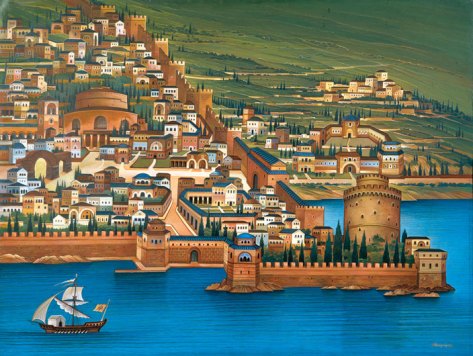



























































5 thoughts on “A Guide to the Byzantine Empire’s Themes (Military/ Administrative Districts)”